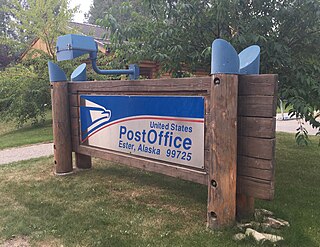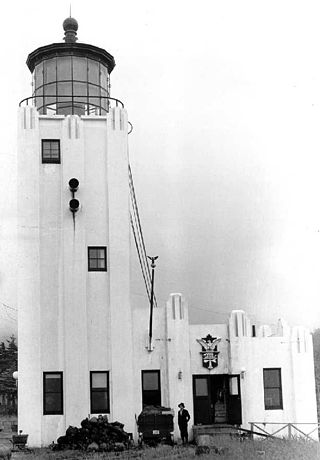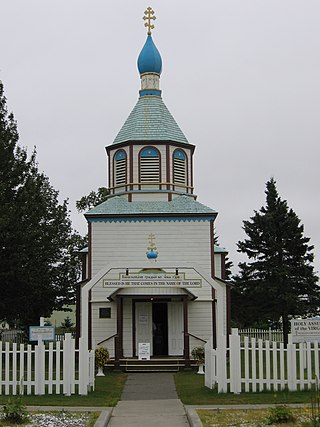
Ester is a census-designated place (CDP) in Fairbanks North Star Borough, Alaska, United States. It is part of the Fairbanks, Alaska Metropolitan Statistical Area. The population in the CDP was 2,422 at the 2010 census, although there are only around 12 houses located inside of the village, the rest are in the surrounding area. The Ester Camp Historic District is a historic district listed on the National Register of Historic Places. Ester was founded as a gold mining camp in the early 1900s, and the economy has focused on mining and services for miners. The Ester Volunteer Fire Department, John Trigg Ester Library, Ester Historic Society and Ester Post Office serve residents in Ester and surrounding areas. There is also a convenience store and secular chapel on the outskirts of the village. Many artists, writers, and musicians reside in Ester.

Klondike Gold Rush National Historical Park is a national historical park operated by the National Park Service that seeks to commemorate the Klondike Gold Rush of the late 1890s. Though the gold fields that were the ultimate goal of the stampeders lay in the Yukon Territory, the park comprises staging areas for the trek there and the routes leading in its direction. There are four units, including three in Municipality of Skagway Borough, Alaska and a fourth in the Pioneer Square National Historic District in Seattle, Washington.

Druid Hills Historic District is a historic district in Druid Hills and Atlanta in DeKalb County, Georgia, United States, that is listed on the National Register of Historic Places (NRHP).

The Cape Hinchinbrook Light is a lighthouse located near the southern end of Hinchinbrook Island adjacent to Prince William Sound, in Alaska, United States.

The Henry Weinhard Brewery complex, also the Cellar Building and Brewhouse and Henry Weinhard's City Brewery, is a former brewery in Portland, Oregon. Since 2000, it has been listed on the National Register of Historic Places. In that same year, construction began to reuse the property as a multi-block, mixed-use development known as the Brewery Blocks.

Holy Assumption Orthodox Church, also known as Church of the Assumption of the Virgin Mary, is a Russian Orthodox parish church in Kenai, Kenai Peninsula Borough, Alaska, United States. Completed in 1896, it is the oldest-standing Russian Orthodox church in Alaska and was a major center for the assimilation of the local Native population. It was declared a National Historic Landmark in 1970 and was added to the National Register of Historic Places shortly after.

SS Nenana is a five-deck, western river, sternwheel paddleship. Two-hundred and thirty-seven feet in overall length, with a 42-foot beam, she was rated at 1,000 gross tons register. Nenana was built at Nenana, Alaska, and launched in May 1933. Marine architect W.C. Nickum of Seattle designed the sternwheeler, which was prefabricated in Seattle and put together at Nenana, Alaska, by Berg Shipbuilding Company. Nenana was built to serve as a packet. She could carry both passengers and freight. Nenana had accommodations for 48 passengers on her saloon deck. Up to 300 tons of freight, including two tons in cold storage, could be carried on her main deck. A Texas, topped by a pilothouse mounted forward in poolboat style, provided staterooms for a portion of the crew of 32. Nenana could push five or six barges on the Yukon River; but, because of sharp bends, only one on the Tanana River.

This is a list of the National Register of Historic Places listings in Dillingham Census Area, Alaska.

This is a list of the National Register of Historic Places listings in Nome Census Area, Alaska.

This is a list of the National Register of Historic Places listings in Fairbanks North Star Borough, Alaska.

This is a list of the National Register of Historic Places listings in Kodiak Island Borough, Alaska.

The Masonic Temple was a historic two-story wooden building at 809 1st Avenue, near the Chena River in Fairbanks, Alaska. It was built in 1906, expanded in 1908, and further altered in 1913 and 1916. Its architecture was "eclectic Renaissance Revival", a style that had been popular in the "lower 48" United States in the 1880s and 1890s. It was listed on the National Register of Historic Places in 1980.

The John R. Twelves House is a historic house located in Provo, Utah, United States. It is listed on the National Register of Historic Places.

The Discovery Saloon is a historic building at 1st and D Streets in Nome, Alaska. Now a private residence, this two-story wood-frame building with false front was built in 1901 by Max Gordon, who operated a high-end public establishment on the premises. It is the oldest commercial building in Nome, and one of the few to survive from Nome's gold rush days. It was converted to one of Nome's finest private residences in the 1940s.
Pilgrim Hot Springs is a ghost town in the interior of the Seward Peninsula of northwestern Arctic Alaska. Also known as Kruzgamepa, it is located on the southeast bank of the Kruzgamepa River, about 8 miles (13 km) south of milepost 65 of the Kougarok Road. The location gained prominence in the early 20th century because of its thermal hot springs, which made agricultural homesteading possible, and which were adapted to provide a respite for the gold miners of Nome. Early buildings, built 1900–03, were of log construction, and included a log cabin, barn and chicken house. A roadhouse and saloon were built after 1903, but were destroyed by fire in 1908, after the mining boom had ended.

State and Prospect District is a national historic district located at Indianapolis, Indiana. The district encompasses eight contributing buildings and one contributing object in the Fountain Square Commercial Areas of Indianapolis. It developed between about 1871 and 1932, and notable buildings include the Mitschrich / Schaefer Feed Store, Sommer / Roempke Bakery, and Lorber's Saloon (1885).

The Cedar Rapids Central Business District Commercial Historic District is a nationally recognized historic district located in Cedar Rapids, Iowa, United States. It was listed on the National Register of Historic Places in 2015. At the time of its nomination it consisted of 60 resources, which included 46 contributing buildings, one contributing structure, 12 non-contributing buildings, and one non-contributing structure. Cedar Rapids was platted on the east bank of the Cedar River as Rapids City in 1841, and it was incorporated under the same name in 1849. Kingston was established on the west bank of the river in 1852. The two smaller communities consolidated in 1870 as Cedar Rapids. The streets were laid out parallel and perpendicular to the river, which flowed from the northwest to the southeast. The Chicago, Iowa and Nebraska Railroad was the first to arrive in the community in 1859 and the tracks were laid on Fourth Street on the eastern edge of the central business district. The first bridge across the river was built at Third Avenue in 1871.

The Stapleton Building was a historic building at 751 North Main Street in Waterbury, Connecticut. Built in 1903, it was a good example of Renaissance Revival architecture, and typified economic development in outlying neighborhood areas of Connecticut's larger cities. The building was listed on the National Register of Historic Places in 1988. It has since been demolished.



















